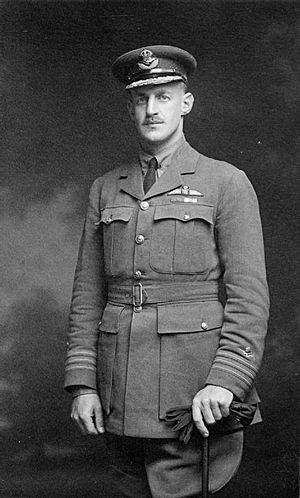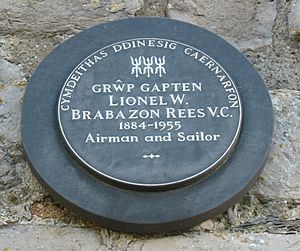Lionel Rees facts for kids
Quick facts for kids
Lionel Wilmot Brabazon Rees
|
|
|---|---|

Lionel Rees c.1918
|
|
| Born | 31 July 1884 Caernarfon, Carnarvonshire, Wales |
| Died | 28 September 1955 (aged 71) Nassau, Bahamas |
| Buried |
Nassau War Cemetery, Bahamas
|
| Allegiance | United Kingdom |
| Service/ |
British Army Royal Air Force |
| Years of service | 1902–1931 c.1939–1942 |
| Rank | Group Captain |
| Unit | Royal Garrison Artillery Royal Flying Corps |
| Commands held | No. 11 Squadron RFC No. 32 Squadron RFC |
| Battles/wars | First World War Second World War |
| Awards | Victoria Cross Officer of the Order of the British Empire Military Cross Air Force Cross Mentioned in Despatches |
Group Captain Lionel Wilmot Brabazon Rees (born 31 July 1884 – died 28 September 1955) was a brave Welsh pilot. He was known as a "flying ace" because he shot down at least five enemy aircraft. He received the Victoria Cross, which is the highest award for bravery in battle for British and Commonwealth soldiers.
Rees was also very interested in old history. In the 1920s, he flew over places like Jordan and took some of the first aerial photos of ancient sites. This helped start a new way of studying history from the air. He also loved sailing.
Contents
Early Life and Education
Lionel Rees was born in Caernarfon, Wales, on 31 July 1884. His father, Charles Herbert Rees, was a lawyer and a military officer. Lionel went to Eastbourne College and then to the Royal Military Academy, Woolwich, which is a school for army officers.
In 1903, he joined the Royal Garrison Artillery, a part of the British Army. He was sent to places like Gibraltar and Sierra Leone.
First World War Heroics
Before the war, in 1912, Rees learned to fly planes at his own cost. He earned his pilot's license in 1913. When the First World War started in 1914, he joined the Royal Flying Corps, which was the air force at the time. He started as an instructor, teaching others to fly.
In 1915, he became the leader of a new group called No. 11 Squadron. They moved to France. Rees quickly became known as a daring pilot and a very good shot. He flew a plane called the Vickers Gunbus.
Military Cross Award
Lionel Rees was awarded the Military Cross for his brave actions in 1915. This award is given for bravery during battle.
One time, on 21 September 1915, he was flying alone with his gunner, Flight-Sergeant Hargreaves. They saw a large German plane below them. Even though the German plane had two machine guns and was faster, Captain Rees attacked it. He kept fighting until he hit the enemy's engine, and the German plane crashed.
Another time, on 28 July, he attacked an enemy plane even after his own plane was badly damaged. On 31 August, he fought a stronger German plane for a long time. He even went back to get more ammunition and returned to finish the fight, bringing the enemy plane down.
By this time, he had shot down or forced down eight enemy aircraft.
Victoria Cross Bravery
In June 1916, Major Rees took command of No. 32 Squadron and went back to France. On 1 July 1916, during the start of the Battle of the Somme, he showed incredible bravery.
He was on patrol in his plane, an Airco DH.2. He saw what he thought were friendly planes, but they turned out to be enemy aircraft. One of them attacked him, but he fought back and damaged it. Then, several other enemy planes attacked him from a distance. He managed to scatter them, seriously damaging two of them.
He chased two more enemy planes. During the fight, a bullet hit his leg, making it hard to control his plane. But he managed to get control back and kept fighting. He used up all his ammunition, firing at the enemy from very close range. Even though he was wounded, he broke up the enemy formation.
After the fight, he flew his damaged plane safely back to base. He calmly asked for help to get out of his plane and was taken to the hospital. His amazing courage earned him the Victoria Cross.
After the Wars
After the First World War, Lionel Rees received more awards. In 1918, he got the Air Force Cross for his valuable flying skills. In 1919, he was made an Officer of the Order of the British Empire. He then joined the new Royal Air Force (RAF) as a high-ranking officer.
In the 1920s, Rees continued his career in the RAF. He was promoted to group captain. In 1926, he was put in charge of the RAF in Jordan and Palestine. This is where his interest in archaeology grew. He took many early aerial photographs of ancient sites while flying. He is now seen as a pioneer in using planes to find and study historical places.
In 1931, he retired from the RAF. In 1933, he sailed alone across the Atlantic Ocean from Wales to the Bahamas. This was a very impressive journey, and he received an award for it.
When the Second World War began, Rees returned to the RAF. He served in Africa. After the war, he went back to the Bahamas. He married Sylvia Williams and they had three children.
Death and Lasting Impact
Lionel Rees passed away on 28 September 1955, in Nassau, Bahamas, from a blood illness. He was buried in the Nassau war cemetery. He was known as a true gentleman and often gave his salary to charities.
In 2019, an RAF jet was named in his honor by No. 32 Squadron, the same squadron he once commanded.
Selected Writings
Lionel Rees also wrote several articles and a book:
- 1916: Fighting in the Air (a book about air combat)
- 1927: 'Ancient Reservoirs near Kasr Azrak' (about old water systems)
- 1929: 'The Transjordan Desert' (about the desert in Jordan)
- 1930: 'Transjordan: an ancient and a modern raid'
- 1948: 'The Route of the Exodus: The First Stage, Ramies to Etham' (about ancient travel routes)


